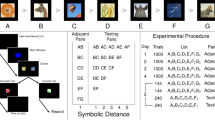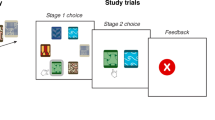Abstract
We examined how the brain organizes interrelated facts during learning and how the facts are subsequently manipulated in a transitive inference (TI) paradigm (e.g., if A<B and B<C, then A<C). This task determined features such as learned facts and behavioral goals, but the learned facts could be organized in any of several ways. For example, if one learns a list by operating on paired items, the pairs may be stored individually as separate facts and reaction time (RT) should decrease with learning. Alternatively, the pairs may be stored as a single, unified list, which may yield a different RT pattern. We characterized RT patterns that occurred as participants learned, by trial and error, the predetermined order of 11 shapes. The task goal was to choose the shape occurring closer to the end of the list, and feedback about correctness was provided during this phase. RT increased even as its variance decreased during learning, suggesting that the learnt knowledge became progressively unified into a single representation, requiring more time to manipulate as participants acquired relational knowledge. After learning, non-adjacent (NA) list items were presented to examine how participants reasoned in a TI task. The task goal also required choosing from each presented pair the item occurring closer to the list end, but without feedback. Participants could solve the TI problems by applying formal logic to the previously learnt pairs of adjacent items; alternatively, they could manipulate a single, unified representation of the list. Shorter RT occurred for NA pairs having more intervening items, supporting the hypothesis that humans employ unified mental representations during TI. The response pattern does not support mental logic solutions of applying inference rules sequentially, which would predict longer RT with more intervening items. We conclude that the brain organizes information in such a way that reflects the relations among the items, even if the facts were learned in an arbitrary order, and that this representation is subsequently used to make inferences.
Similar content being viewed by others
Author information
Authors and Affiliations
Corresponding author
Additional information
An erratum to this article is available at http://dx.doi.org/10.1007/s00221-002-1226-2.
Rights and permissions
About this article
Cite this article
Acuna, B.D., Sanes, J.N. & Donoghue, J.P. Cognitive mechanisms of transitive inference. Exp Brain Res 146, 1–10 (2002). https://doi.org/10.1007/s00221-002-1092-y
Received:
Accepted:
Published:
Issue Date:
DOI: https://doi.org/10.1007/s00221-002-1092-y




